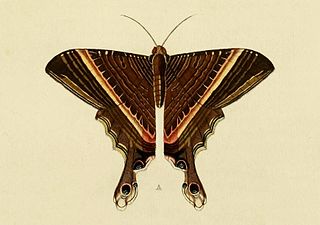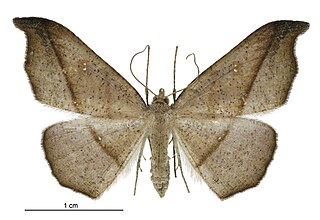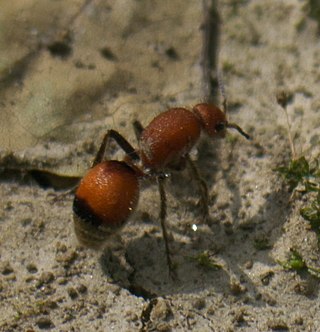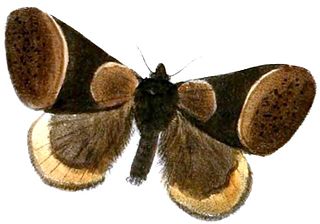
Macrolepidoptera is a group within the insect order Lepidoptera. Traditionally used for the larger butterflies and moths as opposed to the "microlepidoptera", this group is artificial. However, it seems that by moving some taxa about, a monophyletic macrolepidoptera can be easily achieved. The two superfamilies Geometroidea and Noctuoidea account for roughly one-quarter of all known Lepidoptera.

The Pentatomomorpha comprise an infraorder of insects in the true bug order Hemiptera. It unites such animals as the stink bugs (Pentatomidae), flat bugs (Aradidae), seed bugs, etc. They are closely related to the Cimicomorpha.

The Lygaeoidea are a sizeable superfamily of true bugs, containing seed bugs and allies, in the order Hemiptera. There are about 16 families and more than 4,600 described species in Lygaeoidea, found worldwide. Most feed on seeds or sap, but a few are predators.

Callidulidae, the only known family of the superfamily Calliduloidea, is the family of Old World butterfly-moths, containing eight genera. They have a peculiar distribution, restricted to the Old World tropics of Southeast Asia to Australasia and Madagascar. The three subfamilies exhibit both day- and night-flying behaviour.

Sematuridae is a family of moths in the lepidopteran order that contains two subfamilies.

Larentiinae is a subfamily of moths containing roughly 5,800 species that occur mostly in the temperate regions of the world. They are generally considered a subfamily of the geometer moth family (Geometridae) and are divided into a few large or good-sized tribes, and numerous very small or even monotypic ones which might not always be valid. Well-known members are the "pug moths" of the Eupitheciini and the "carpets", mainly of the Cidariini and Xanthorhoini. The subfamily was described by Philogène Auguste Joseph Duponchel in 1845.

The insect order Lepidoptera consists of moths, most of which are night-flying, and a derived group, mainly day-flying, called butterflies. Within Lepidoptera as a whole, the groups listed below before Glossata contain a few basal families accounting for less than 200 species; the bulk of Lepidoptera are in the Glossata. Similarly, within the Glossata, there are a few basal groups listed first, with the bulk of species in the Heteroneura. Basal groups within Heteroneura cannot be defined with as much confidence, as there are still some disputes concerning the proper relations among these groups. At the family level, however, most groups are well defined, and the families are commonly used by hobbyists and scientists alike.

The Obtectomera is a clade of macro-moths and butterflies, comprising over 100,000 species in at least 12 superfamilies.
Asestra is a genus of moths in the family Geometridae. It was described by William Warren in 1895.
Cossina is the name for both a section and subsection of Ditrysian insects in the order containing both butterflies and moths having a dorsal heart vessel. The section named Cossina contains two subsections: one also named Cossina having pupae with dorsal spines; and subsection Bombycina having spineless pupae.

Sarisa is a monotypic moth genus in the family Geometridae and was first described by David Stephen Fletcher in 1979. The genus contains only one species, Sarisa muriferata, the hook-tip fern looper, which is endemic to New Zealand and surrounding islands. This species was described by Francis Walker in 1862. It is widespread in the North and South Islands, and has been recorded from Stewart Island, Big South Cape Island, the Chatham Islands and the Auckland Islands.

Zythos is a genus of moths in the family Geometridae. It was described by David Stephen Fletcher in 1979.
Bombycina is the name for a subsection of Ditrysian insects in order containing both butterflies and moths having a dorsal heart vessel. Subsection Bombycina contains generally larger sized moths and butterflies in the superfamilies Bombycoidea, Calliduloidea, Cimelioidea, Drepanoidea, Geometroidea, Noctuoidea, and Papilionoidea, having spineless pupae.

Pompiloidea is a superfamily that includes spider wasps and velvet ants, among others, in the order Hymenoptera. There are 4 families in Pompiloidea.
The Macroheterocera are a well supported clade of moths that are closely related to butterflies and macro-moths.

Pseudobistonidae is a family of Asian moths in the superfamily Geometroidea. It was erected in 2015 and contained Pseudobiston pinratanai as its only species. A second species was moved into this family in 2019: Heracula discivitta, in a new subfamily called Heraculinae.
Phytophaga is a clade of beetles within the infraorder Cucujiformia consisting of the superfamilies Chrysomeloidea and Curculionoidea that are distinctive in the plant-feeding habit combined with the tarsi being pseudotetramerous or cryptopentamerous, where the fourth tarsal segment is typically greatly reduced or hidden by the third tarsal segment. The Cucujoidea are a sister to the Phytophaga. In some older literature the term Phytophaga was applied only to the Chrysomeloidea.












